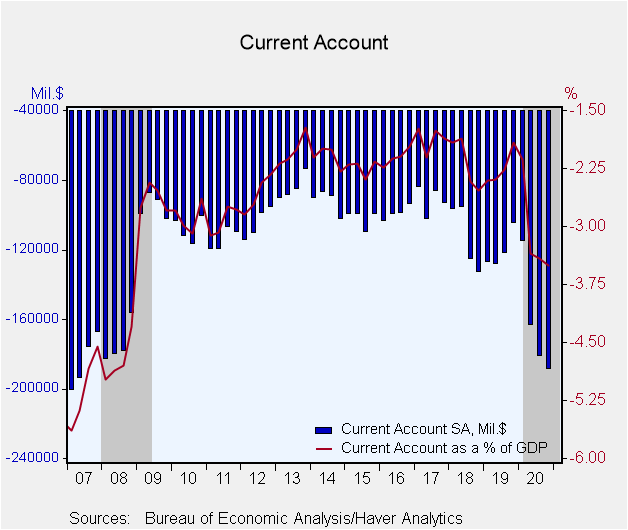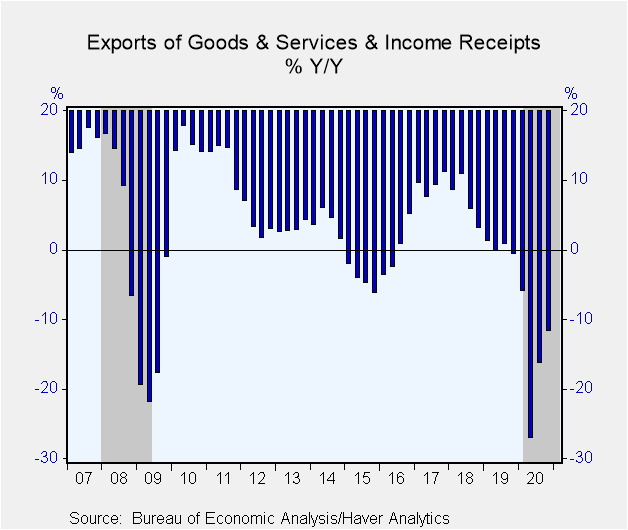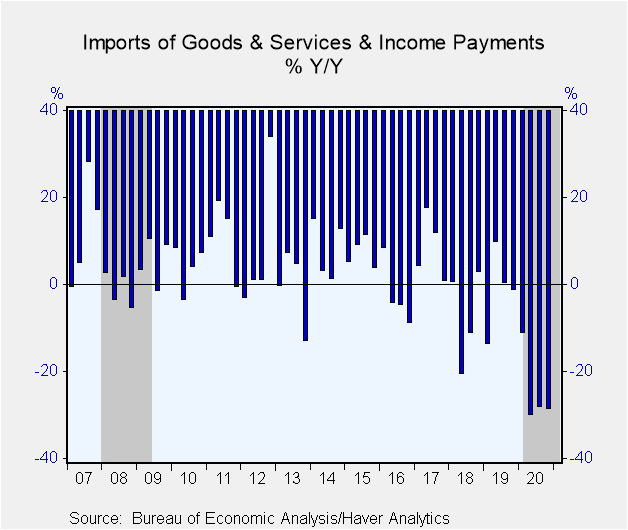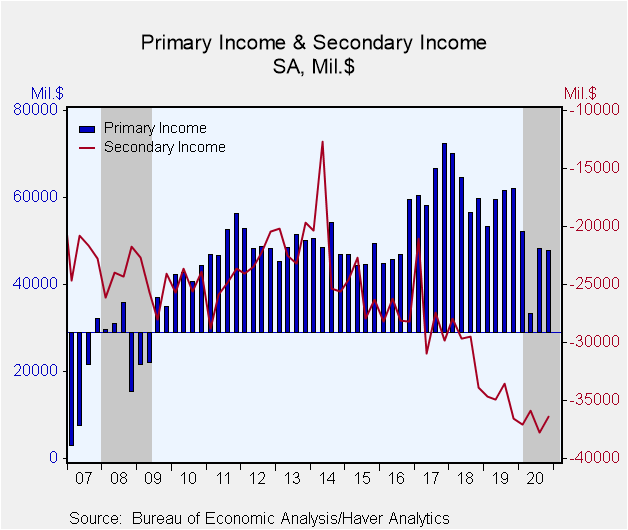 Global| Mar 23 2021
Global| Mar 23 2021U.S. Current Account Deficit Widens in Q4'20
by:Tom Moeller
|in:Economy in Brief
Summary
• Goods trade deficit sets record in 2020. • Services trade surplus declines to eight-year low. The U.S. current account deficit deepened to $188.5 billion during Q4'20 following a widening to $180.9 billion in Q3'20, revised from [...]
• Goods trade deficit sets record in 2020.
• Services trade surplus declines to eight-year low.
The U.S. current account deficit deepened to $188.5 billion during Q4'20 following a widening to $180.9 billion in Q3'20, revised from $178.5 billion. The Action Economics Forecast Survey anticipated a $188.0 billion deficit. As a percent of GDP, the deficit grew slightly to 3.5%, it's deepest since Q4'08. During all of 2020, the current account deficit deepened to $647.2 billion from $480.2 billion.
The deficit in goods trade deteriorated to $253.0 billion as exports grew 8.7% (-5.8% y/y) in Q4. All export categories increased. Capital goods exports rose 5.7% (-12.9% y/y) and auto exports increased 4.8% (-3.9% y/y). Exports of nonauto consumer goods increased 8.9% (-1.7% y/y) while foods, feeds & beverage exports grew 15.1% (24.6% y/y). Imports of goods rose 6.0% (4.3% y/y) in Q4. The gain reflected a 12.8% increase (7.8% y/y) in auto imports and a 5.6% rise (4.0% y/y) in capital goods imports. Nonauto consumer goods import improved 6.1% (13.7% y/y) but foods, feeds & beverage imports eased 0.2% (+6.9% y/y).
The surplus on services trade narrowed to $53.0 billion in Q4. Services exports rose 2.3% (-24.0% y/y) as travel exports strengthened 18.2% (-73.5% y/y). Export charges for the use of intellectual property improved 4.2% (0.1% y/y). Imports of services strengthened 6.3% (-22.4% y/y), reflecting a 70.5% rise (-79.6% y/y) in travel imports in Q4. Imports of charges for the use of intellectual property increased 0.6% (-3.1% y/y).
The surplus on primary income rose to $47.9 billion after increasing sharply in Q3. Investment income receipts rose 3.0% (-12.2% y/y) while investment income payments increased 3.7% (-9.1% y/y). The deficit on secondary income narrowed slightly to $36.4 billion after deteriorating to a record $37.7 billion in Q3.
Balance of Payments data are in Haver's USINT database, with summaries available in USECON. The expectations figure is in the AS1REPNA database.
| U.S. Balance of Payments SA | Q4'20 | Q3'20 | Q2'20 | 2020 | 2019 | 2018 |
|---|---|---|---|---|---|---|
| Current Account Balance ($ Billion) | -188.5 | -180.9 | -163.2 | -647.2 | -480.2 | -449.7 |
| As % of GDP | -3.5 | -3.4 | -3.4 | -3.1 | -2.2 | -2.2 |
| Balance on Goods ($ Billion) | -253.0 | -247.5 | -221.5 | -915.6 | -864.3 | -880.3 |
| Exports (% Chg) | 8.7 | 23.8 | -28.5 | -13.2 | -1.5 | 7.7 |
| Imports (% Chg) | 6.0 | 18.5 | -14.6 | -6.6 | -1.6 | 8.5 |
| Balance on Services ($ Billion) | 53.0 | 56.1 | 60.8 | 233.9 | 287.5 | 300.4 |
| Exports (% Chg) | 2.3 | 1.6 | -18.3 | -21.0 | 1.6 | 3.9 |
| Imports (% Chg) | 6.3 | 7.2 | -24.6 | -22.1 | 4.7 | 3.2 |
| Balance on Primary Income ($ Billion) | 47.9 | 48.2 | 33.3 | 181.6 | 236.3 | 251.2 |
| Balance on Secondary Income ($ Billion) | -36.4 | -37.7 | -35.9 | -147.1 | -139.7 | -120.9 |
Tom Moeller
AuthorMore in Author Profile »Prior to joining Haver Analytics in 2000, Mr. Moeller worked as the Economist at Chancellor Capital Management from 1985 to 1999. There, he developed comprehensive economic forecasts and interpreted economic data for equity and fixed income portfolio managers. Also at Chancellor, Mr. Moeller worked as an equity analyst and was responsible for researching and rating companies in the economically sensitive automobile and housing industries for investment in Chancellor’s equity portfolio. Prior to joining Chancellor, Mr. Moeller was an Economist at Citibank from 1979 to 1984. He also analyzed pricing behavior in the metals industry for the Council on Wage and Price Stability in Washington, D.C. In 1999, Mr. Moeller received the award for most accurate forecast from the Forecasters' Club of New York. From 1990 to 1992 he was President of the New York Association for Business Economists. Mr. Moeller earned an M.B.A. in Finance from Fordham University, where he graduated in 1987. He holds a Bachelor of Arts in Economics from George Washington University.










